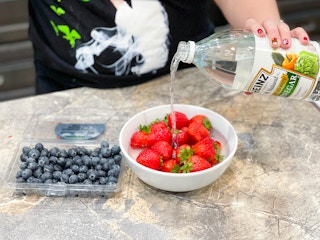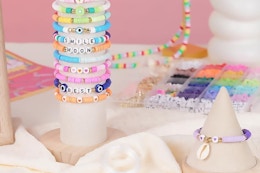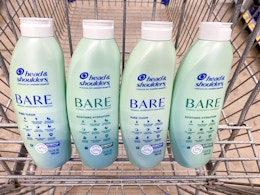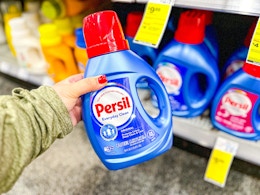Knowing proper produce storage is essential if you’re trying not to break the bank as you maintain a healthy diet. Is there anything worse than buying a bunch of avocados, waiting for them to ripen and then suddenly, they’re too squishy? Or how about being tempted by that uber-affordable Costco bag of broccoli, only to find it’s slimy because you didn’t finish it soon enough?
No more! Learn how to store fruits and vegetables to make your fresh produce last as long as possible. Plus, I’ve got a few tips and tricks to learn how to squeeze extra days out of your fruit and vegetable storage, and keep reading for some extra-credit money-saving tips on produce.
(Need to save money right now? Check out these produce coupons.)

Download the free printable PDF of this Fresh Produce Cheat Sheet to keep in your kitchen!
How to store potatoes

Potatoes will keep for two weeks when stored in a cool, dark, dry location (a non-refrigerated 45 to 55 degrees is ideal). They like breathing room, so open containers work best. Think: open paper bags or cardboard boxes. Avoid plastic, and always avoid a tight seal.
Potato sprouts contain a toxin called solanine, so always discard all sprouts and green spots before eating.
Store potatoes with an apple to keep them from sprouting.

Some produce — like apples, emit ethylene — a gas that scientists consider an “aging hormone” for fruits and veggies. This ethylene gas apples put out actually prevents potatoes from sprouting, making them last longer.
How to store ginger, carrots, and beets

Peel, cut, and freeze ginger.

After you buy ginger, just peel it and chop it into different sized pieces, both big and small. Toss the pieces in a freezer bag for convenient use later.
Cut the greens off carrots and store in a covered container filled with water.

Be sure to change the water every four to five days, and your carrots can last up to a month in the refrigerator.
Store beets and their greens separately.

How to store onions and garlic

Do not store onions in plastic bags, because the lack of air movement will accelerate spoiling and sprouting.
Store onions in pantyhose.

Tie knots in between individual onions, and hang groups vertically in your pantry so each onion is protected and has space.
Punch holes in paper bags to store onion and garlic.

Use a hole punch and paper clips to create a nice little home for onions and garlic.
How to store green onions

Green onions require a different produce storage approach than onions and garlic. Think of them more like you would a leafy green. They need to stay dry and sealed to keep their flavor and crunch. (And to avoid getting slimy!)
Wrap green onions in paper towels and store them in sandwich bags for up to two weeks.
Chop green onions, and store the pieces in a water bottle in the freezer.

Without the water, of course! This produce storage method should keep green onions fresh for up to three weeks. The water bottle allows for easy dispensing, but you can use any freezer-safe container.
How to store avocado

To encourage a whole avocado to ripen, leave it on the countertop, and to get it to halt the ripening process, put it in the refrigerator. It’ll ripen in a couple days and it’ll stay ripe up to three days in the refrigerator.
Press plastic wrap tightly against an avocado half and then seal it.

The internet has lots of suggestions for keeping a cut avocado green. Submerge it in water, store it with an onion, and brush it with lemon juice or olive oil are some of the fan favorites. But one journalist found that good, old-fashioned wrapping avocado up tightly and putting it in the fridge was best.
How to store cilantro, fresh basil, lettuce, and kale

The one thing all of these leafy greens have in common is the need for an airtight food container or Ziploc bag.
Cilantro and basil are considered “tender” herbs and can last for up to three weeks when stored properly.
Lettuce can last up to ten days and kale up to seven days.
Place cilantro in water and loosely cover it with a plastic bag.

Snip the bottoms off cilantro stems, place them in water, and cover loosely with a plastic bag. Herbs like cilantro and parsley do best in the refrigerator, while herbs like basil should sit at room temperature. Herbs can stay fresh for up to two weeks.
Dice and freeze fresh basil in olive oil.

Pour the mixture into ice cube trays. This is a great way to add some pizzazz to a meal when you’re short on time, or if you want to save the herbs from your garden at the end of the season.
Revive lettuce that’s on the fritz with an ice bath.

Lettuce looking a little wilty? Place it in a bowl of ice water for a few minutes to restore some crunch and then use it up as soon as possible!
Separate and layer a head of kale with paper towels.

This layering technique is a good way for kale to stay fresh for the full seven days, sometimes longer. Make sure you dry each leaf thoroughly.
How to store broccoli

Broccoli likes a little moisture and a loose paper towel wrap in an unsealed storage bag. No airtight containers; raw broccoli likes to breathe, and it can stay fresh for up to five days when properly stored.
Stand broccoli heads up in water to keep them fresh longer.

This won’t work with cut florets, but if you’ve got the whole head of broccoli still, add a quarter of an inch of water to a low, wide bowl (a cereal bowl might work), and stand the broccoli up in it. Like flowers, the stem will transfer the water to the head and keep fresh longer.
How to store strawberries and blueberries

Berries are fussy! But they’re expensive, and so anything you can do to lengthen their lives is worth it. Kept dry and refrigerated, hearty berries like strawberries and blueberries can last up to seven days. More fragile berries like raspberries last up to five days.
Wash strawberries and blueberries in a vinegar solution.

Pinky promise they won’t taste like vinegar! Soak strawberries in a three-parts-water, one-part-vinegar solution. Next, put them in a colander and run cool water over them until they’re completely rinsed. Pat dry and store them in a larger container than what they came in. Make sure moisture can escape.
See all Driscoll’s coupons for strawberries or blueberries.
How to store cucumbers

Store whole cucumbers in your refrigerator door for up to six days. You don’t need to wrap them up or mess with them much at all. As long as they stay cool, but not too cold (50 degrees is ideal, hence the refrigerator door where it’s not as cold as other spots), they’ll be fine.
Submerge sliced cucumbers in water to keep them crispy longer.

Fill a food storage container with water, and dunk your sliced cucumbers, then seal with a lid. This produce storage trick will keep cuts longer than simply putting them in a sandwich bag might. The water keeps them from drying out and getting flimsy.
How to store mushrooms

Whole mushrooms are good for up to ten days in the refrigerator. Sliced mushrooms will go bad a bit sooner, lasting just seven days.
Store mushrooms in a paper bag.

This method gives mushrooms a longer shelf life. The paper bag will absorb the moisture from the mushrooms, which keeps them from getting soggy.
How to store tomatoes

Store tomatoes in Debbie Meyer GreenBags.

Debbie Meyer GreenBags actually work and will help tomatoes last for weeks. Each bag can be used up to ten times!
How to store asparagus

Asparagus is best eaten the day it’s bought, but I know that’s not always possible.
Store asparagus in a produce bag or loosely wrapped in plastic. Be sure to keep it in the high-humidity produce drawer! It can last up to four days this way.
Trim 1/4 inch off the bottoms of asparagus and place it in water.

Asparagus is like a bouquet in your refrigerator! Watch your trimmed asparagus stay fresh for a week, sometimes even two weeks. You might cover the asparagus with a clean plastic bag, but it’s optional.
How to store apples

Pick your own apples from an orchard, or get them from a farmers’ market to buy more time.

Apples notoriously have a long (I’m talking up to six months!) shelf life. The way to capitalize on this is to buy directly from orchards. Store-bought apples have already been stored for a very long time before you even buy them.
How to store celery

When kept in the refrigerator, celery can last up to two weeks.
Wrap celery in foil before refrigerating.

Storing celery in foil helps keep just the right amount of moisture in without being too airtight so ethylene gas can’t be released. This also keeps it crisp.
How to store lemons, oranges, and limes

It looks pretty, but a bowl of lemons or limes on the countertop isn’t the best produce storage method to keep fruit you want to use. Instead, put them (along with oranges) in the refrigerator. Lemons, limes, and oranges last in the refrigerator for up to two weeks.
Store lemons and limes submerged in water.

Whole lemons or limes, an airtight container (a gallon Ziploc bag works), and water will keep the fruit’s moisture intact, extending its shelf life to six weeks in the refrigerator.
Wrap oranges individually in parchment paper.

Doing this and then placing the box of oranges in your refrigerator will extend the orange’s life to six weeks, but check regularly for any signs of decay.
Freeze sliced citrus on baking sheets.

Transfer frozen citrus slices or wedges to a freezer bag. Keep frozen until you’re ready to use them.
How to store bananas

Hang bananas in a dark and cool room for the best chance at making them last. Bananas are sensitive to ethylene gas, so keep them separate from other fruits and vegetables unless you want them to ripen!
Stored properly, bananas should last for up to five days. Once ripe, you can squeeze out a few extra days by putting them in the refrigerator. The peels will brown, but the fruit will be just fine!
Peel bananas completely to freeze them for smoothies.

Not sure you’ll get to those bananas in time? You can freeze them (peeled) for up to three months, possibly longer. They’ll taste best in a smoothie or as an ingredient in banana bread.
How to save money on produce:

- Shop for fruits and veggies at ALDI. Across the board, produce prices are lower at ALDI than anywhere else (yes, even Walmart!). Be picky, though. Quality can be hit or miss.
- Get up to 40% off supermarket prices at MisfitsMarket.com. Misfits Market sells “ugly” (but not bruised or rotten!) produce at a steep discount, because grocery stores like pretty produce, believing it sells better. This is a subscription box, and “you get what you get” in a weekly delivery. You don’t choose your items.
- Download Ibotta and Checkout51 for cash-back offers on produce. You’ll see offers like $0.25 back when you buy green beans, strawberries, or blueberries. Scan your receipt after you buy to get credited via PayPal. Best part? You can combine these offers with paper coupons!
UP NEXT: 22 Ways to Save Money at Whole Foods









































































